Tags
environment, EPA, Joe Don Rooney, lead mining, personal discovery, Picher Oklahoma, Tar Creek Superfund Site
I always try my best to speak straight from my heart, and to never say anything I don’t mean. Writing about Picher is no different, it’s just that I can’t say much of anything about it all without having to stop every once in a while and wipe away a tear. I could try for days to explain how my heart strings got so knotted up in the plight of Tar Creek, but even if I could verbalize some of it, I’d never be able to truly express the feeling I get when I turn onto old HWY 69. Anyone who reads this will probably think I’m crazy, but the first time I saw Picher’s trademark tailings piles looming on the horizon, I was somehow returning to a place I’d never been. And on November 2nd, 2008, I did go back.
Weight limit signs blossom alongside HWY 69 almost as if they were wildflowers, leaving those who do not know the story to wonder at what might lie ahead. The vacant buildings that line Main Street seem to lean on one another for support, the soldiers of a lost cause. A billboard next to the water tower asks that residents please ‘do not put lead in their heads’; another puzzling attribute to the half-dead town that would make any naive thru-trafficker wonder aloud at the gravity of the secrets that lie just beneath the surface of Picher, OK.
Everyone looks at life a little bit different; some say the glass is half-empty, while others are sure it’s half-full. The Tar Creek struggle is divided in much the same fashion, between those who think the town is beyond repair, and those who don’t feel as if anything was broken to begin with. How one chooses to interpret the current state of Picher depends entirely upon what type of person he or she is. A pessimist? Or an optimist? Perhaps one of the most notorious citizens belonging to the latter of those two categories is an elderly gentleman by the name of Orval “Hoppy” Ray– and his story is definitely worth listening to.
He was born in Picher and started work in the mines when he was just sixteen, toiling beside his father and older brother. When the mines played out in the early seventies he did a stint in the Oregon log woods, but returned to Oklahoma within three weeks. When I asked him him why he didn’t stay longer he simply shrugged his shoulders and said this is home. There is an unmistakable note of pride in his voice when he recollects growing up in Picher, and as he weaves his stories he lovingly refers to the town as “she”. It is clear that he has never met a stranger, as he knows no formalities; he insists everyone call him by his longtime nickname of Hoppy, and when I told him I was from out of state– Arkansas, even– his chipper reply was “That don’t make you a bad person.” An advocate for cleaning up Picher since talk of lead poisoning first began, his stubbornness has won him both fame and infamy around town. Some consider him a hero, others call him a nuisance, but it’s easy to see that ‘proud citizen’ is closer to the truth.
Ask anyone in Picher for directions to Hoppy’s Pastime Mining Museum and they will tell you the exact same thing– “Go down past the four-way stop and it’s on your left… there’s a bunch of mining pictures on the outside, can’t miss it.” The place is old, and though its front is stitched with black and white photographs and there is a rusted ore can standing outside the front door, it somehow blends in. The picture windows are crowded with mining paraphernalia and between them a beat-up metal door is propped open. People seem to gravitate toward that mysterious rectangle of darkness like moths to a flame, tripping dumbly over the cracked thresh hold should the curator’s chipper warning of “watch that first step” not reach them in time. Yes, Hoppy’s door is the portal to a near unimaginable past, and it stays wide open as long as the weather permits.
Inside, the building has a somewhat high ceiling and the floor is simple concrete. Before Hoppy had it certified as a museum, the space was used as a pool hall, and the large tables standing at the back of the room are proof positive of its former identity. It has that smell, if you’ve ever smelled it, of old concrete and old paper and old souls; the walls are made up of a million ghostly faces, miners and buildings alike that don’t exist in Picher today but were once its lifeblood. There isn’t too much light, just what’s offered by the long, uncovered florescent bulbs in the ceiling and what sunlight filters in through the front window. Two glass display cases create a counter behind which the museum curator might stand when he is playing at host and tour guide, but for the most part the ‘touch’ and the ‘do-not-touch’ run together in perfect disarray.
Hop himself is a young eighty-three, his roots tangled deep in the mineral-rich soil of Tar Creek. Picher is just seven years his senior, but don’t let Hoppy’s age fool you into thinking that he’s a tired old man. When I introduced myself to him, he fairly sprang from his chair and at once identified me as “the girl with the real sexy voice”. The May 10th tornadoes took his house, but he still resides in Picher, jokingly telling my mom and I that the bathroom in the apartment where he lives now is bigger than the living room. He lives alone, and for the most part can’t be bothered by the governments’ threats to level his town. A tourist from Colorado wandered into the museum while I was there, and after scrutinizing the situation with the impersonal air of an outsider, he asked Hoppy when the museum was going to be torn down. Hop just gave the man a blank look and said, “Whoever has it in mind to take my building better not be standing too close to me when they tell me their plans.”
And it is that attitude that makes Hoppy Ray somewhat legendary, as well as the life of anyone’s party. This brings me to the drum kit and a set of amplifiers that sit off to one side of the museum’s main room, meshing oddly with the rest of the décor but looking well-loved. Hoppy was quick to tell me that every Monday night (at 6PM, if you’re ever in the area) the museum hosts a gathering of local musicians whose specialties are anything George Strait or Bob Wills has ever sang. Anyone is welcome and everyone contributes, including Hoppy himself with his bass guitar and tinny vocals. Though I went on a Sunday and didn’t get the chance to experience it, I can picture it perfectly in my mind’s eye. It looks like hope; the hope that the EPA and other government officials have declared dead.
We visited for the better part of two hours, me listening to everything Hoppy had to say with starry eyes. The narrator of “The Creek Runs Red” displayed an endless patience for the out-of-place girl acting like she had finally made it home, and for that I am deeply grateful. Before I left him, he spoke to me in the most somber tone of voice I had heard him use yet. He said, “There is a cemetery on the south side of Sallisaw– you’re an Arkie girl, you know the area– and that’s where most of my folks are buried. When I was young it was almost empty, but about ten years ago I went back, and much to my surprise, I found it had filled. It made me realize something–” he paused here, and I filled in the blank, “Time sure don’t wait, does it, Hoppy?” He smiled at me then and agreed, “No, it surely don’t.”
I like to think of Hop and Picher as somehow wrapped up in one another; he will believe in his town as long as there is a breath left in either of them, and I will believe in them both long after they’re gone. When he and I said our drawn-out farewells, I swore to him that I would be back again. He laughed in a good-natured fashion, pausing with his hand on the door of his truck, “Well, girl, it best be soon, because I’m almost eighty-four, you know.” I had to laugh to save myself from crying, telling him he better write me into his will. We both laughed, then he told me he would, and we parted ways.
The journey to Picher is a curios experience; getting there is always effortless, like giving into the magnetic pull of something stronger than you, but leaving is a whole lot harder. I managed somehow, hating the noiselessness of the truck’s tires on the smooth interstate back to Joplin, a stark contrast to the faded and cracked asphalt of Alternate Highway 69. The irony of the words on a church sign in Baxter Springs, KS was almost too much for me to bear, and it says more than I could ever hope to even if I had all the time in the world;
“If only My people will pray, then I will heal their land. –God”
**End notes: I would like to extend my thanks to Lynda Martinez from www.picheroklahomagenealogy.com for her continuous love and support, as well as the rest of the clan there. God has certainly blessed me with some beautiful friendships. Also, my wonderfully patient parents who have been great about driving me to Picher even when they really didn’t want to go– earning me the nickname of “Relentless”. To Hoppy, for submitting my poem to JD Sutter, and for making me feel as if I truly belong in Picher. Also, Joe Don Rooney, because without him I probably wouldn’t even know Tar Creek existed. Despite the fact we have only met briefly, he has been a constant source of inspiration for me, and I wish him and the rest of the Rooney clan all the best.
—————————————–
The tale of my first trip to Picher can be found here:
https://tweedyblues.wordpress.com/2008/11/25/covered-in-chat-plenty-to-say/
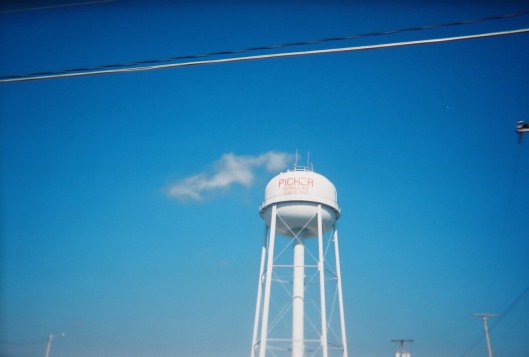
Picher's water tower under a blue sky... just the first of many pictures I snapped that day.
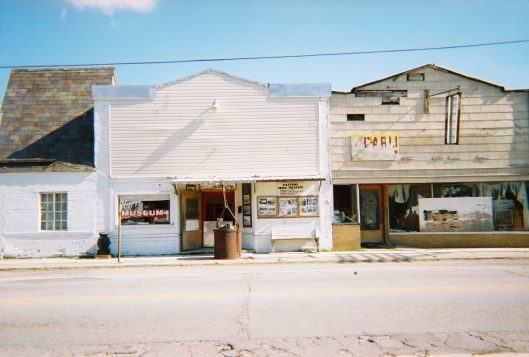
The front of Hoppy's Pastime Mining Museum.
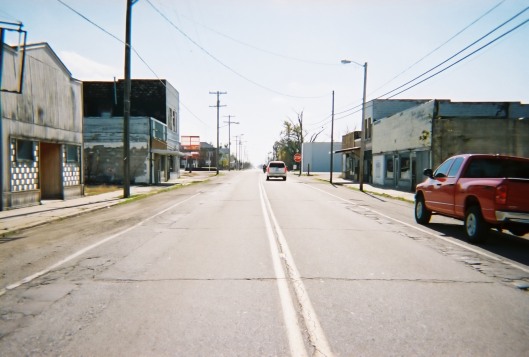
Looking up Highway 69...
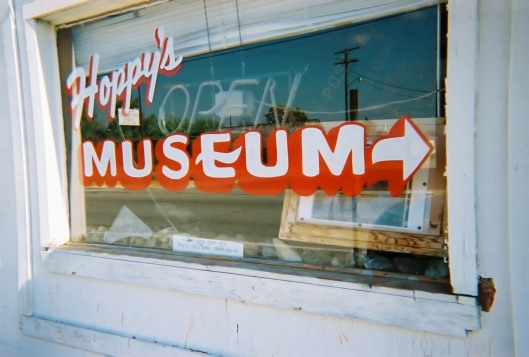
Museum window...
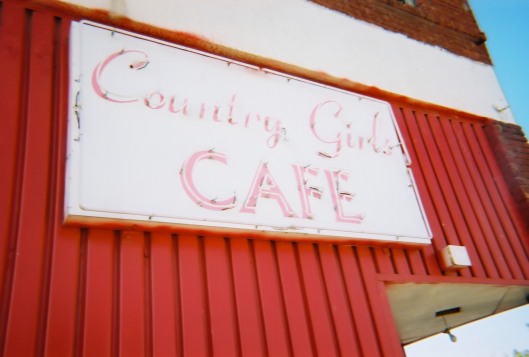
The closing of this cafe was, as Hoppy will tell you, completely uncalled for. It stayed packed from opening to closing time, with customers coming in from as far as Joplin, Missouri. The FDA came in one day, took some measurements, and informed the owner that it was too small a space to house an eating establishment. Without her restaurant, there was nothing to stay for in Picher, and she had to move to nearby Baxter Springs, KS.
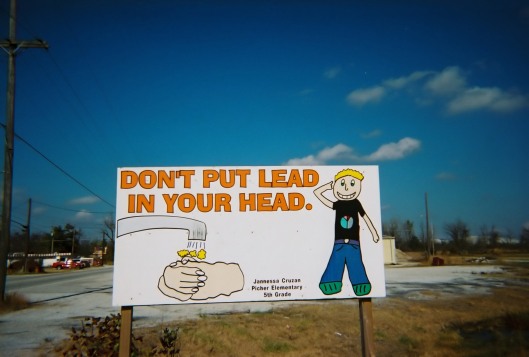
This billboard was designed by a student of Picher Elementary...
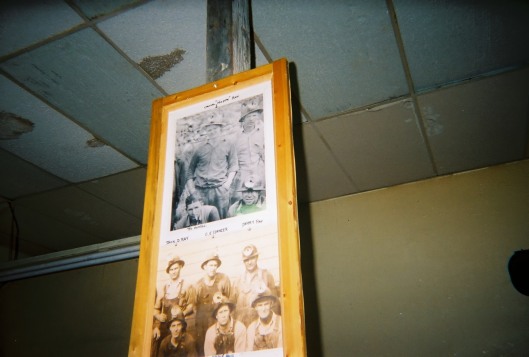
The picture on top is of Hoppy back in his mining days.
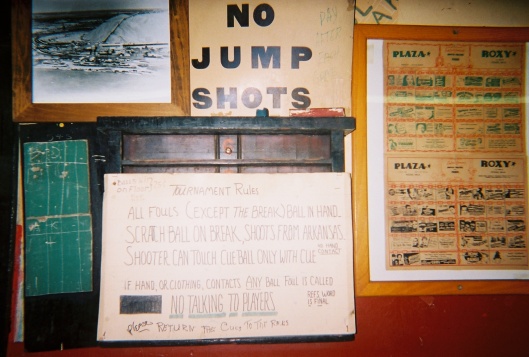
Tournament rules. Now that Hop's place is a museum, he charges his patrons for games of pool and the profits go toward the light/water bill.
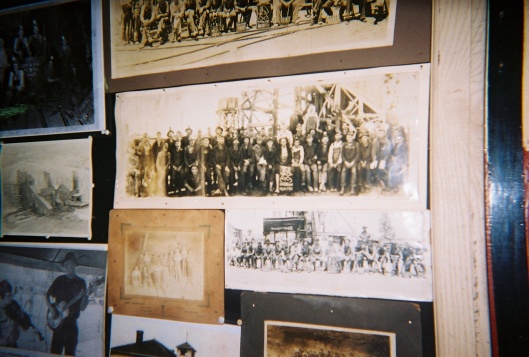
Just a few of many miners' faces that grace the walls of the museum.
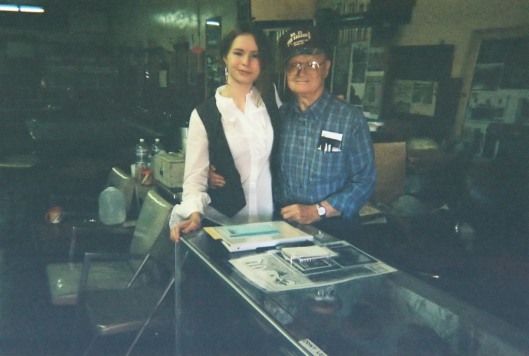
It was so great to finally meet the man who has been so much the equivalent of Picher's voice. He is definitely a hero in my eyes.

Trapper Creek Daughter said:
AMAZING! That’s all I can say…
Megan said:
That’s all I need to hear, TDC. Thanks. <33
Heather said:
wow…. this touched my heart and soul, at times i found myself sobbing so hard i couldnt even see the screan! hearing the story about hop and the poolhall realy brought back memories!!! i grew up in that poolhall ( well i wasnt allowed to go there by my parents) my older brother would play in pool tournaments there and i felt soo grown up to sneek in there and watch him play. I loved reading your story and am greatful as well for you having any intrest in this dying town. My father still lives there in the same house that i was raised in, thank God the tornado didnt touch it.
Rita said:
As I was reading this story, I relized how lucky i am to know Hoppy, I was a teenager in the 70’s so Hoppy is like a second dad to me. Not only me, but every young girl who walked into this pool hallhe was always there if we just wanted to talk or joke around. I knew how he would answer the questions about the building being torn down, that pool hall-museum is more then a building in a run down town, it’s a shelter, it has saved so many teens from trouble. It has so many memories, i can’t imagin that building ever been torn down, it would take away so many memories, hasn’t picher lost enough?.
Pingback: Sunday Stills- Water Towers & Silos « Tweedy Blues
Ryan Reese said:
I think your stories are great. I’ve just recently learned of Picher and have been drawn into it. I live in a small town called Earth, TX and its sad to see these small towns fade away. I would like to see some of your pictures if you would e-mail me some
Kelcey Evans said:
Now that Picher is closed where has the Hoppy’s Past Time Musuem moved to.
I am planing going the the Picher, Ok area.
My granmother lived there and most of my family history is there.
I have never been the that area, but I plan to go there this year.
Megan said:
I’m not sure where he moved to. Most of my good contacts are down. At any rate, I would definitely recommend seeing the Tar Creek area. It will definitely change you. I’d be tickled to death if you emailed me about your visit at firsttimefeelin@hotmail.com. Thanks for dropping by!